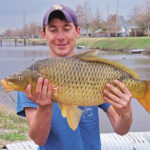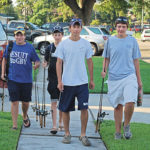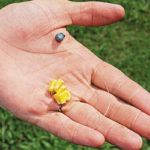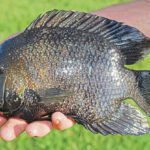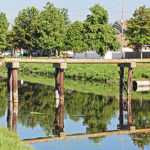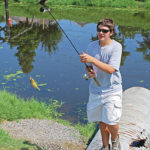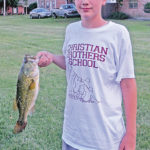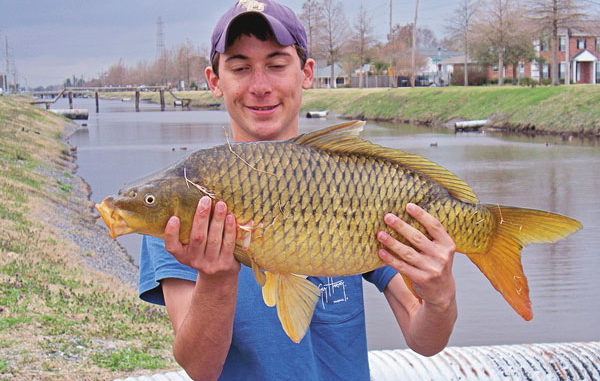
These Metairie boys don’t go very far to find unrivaled fishing action.
Deep in the wilds of Metairie (population 146,136) I join four young men preparing to commit fisheries mayhem. Sights and smells strange to the world of fishing assault my senses as I follow them. Solid middle-class, suburban brick homes set on streets laid on a perfectly rectangular grid pattern surround me. Tie-wearing professional men are backing their cars out of driveways, heading to work. Soccer moms in exercise suits pace past us silently, lost in their iPods.
A lawnmower in the hands of a homeowner trying to beat the day’s predicted scorching heat growls nearby. The smell of newly mowed grass mingles pleasantly with that of bacon being fried for a late breakfast.
I am intrigued.
We are going fishing in the middle of the biggest town in the most populous parish in the state. And surrounded by people, we will likely have the waters to ourselves, something that can’t be said for those fishing deep in the Atchafalaya Basin or in the most remote of Louisiana’s vast marshlands.
Like much of South Louisiana, urban Jefferson Parish is criss-crossed by canals that keep its flat, water-logged terrain in some semblance of being dry. Our destination is Vintage Canal (officially Canal No. 1), naturally enough, paralleling Vintage Street.
The morning sun highlights the straight-as-an-arrow canal. The water in the canal is beautiful — a clear “fishy” green — and is flecked with duckweed. Domestic mallards waddle peacefully to the water’s edge and swim away as we near, but the larger muscovy ducks, with their obscene, nude, red warty faces, give ground only grudgingly.
The boys ignore the ducks as they prepare to fish.
“Wow! Look at that giant school of cichlids,” says one of the boys while eyeing eddying swirls in the canal’s shallows.
My guide for the day is 14-year-old Zach Adams, a dedicated canal angler. He is accompanied by the usual members of his fishing team, his quiet 15-year-old brother Trey, and two friends, Conner Pugh, also 15, and 18-year-old Mitch Rogers.
The curly-haired Conner has an impish grin and mischievous blue eyes. He also identifies himself as “…definitely the best looking one” of the four.
Mitch proudly informs me that he will be entering LSU this fall, and plans to get a degree in marine biology.
The four are armed with nine rods and reels, and immediately put them to work. Conner baits a long-shanked “perch hook” with frozen corn, and casts it to the middle of the canal. As the split shot settles the hook to the bottom, he inserts the handle of the spinning rod in a pipe driven in the ground.
“That’s for carp,” explains Zach. “Our biggest is 17 pounds, and our average is about 8 or 9 pounds.”
It will fish continuously while the boys chase other species.
Conner begins with a green wacky worm, and his target is largemouth bass, a common species in their catch. They have caught bass as large as 5 pounds in the canal.
Mitch is armed with two rods that he carries everywhere he goes. His primary rod is rigged with a small Beetle Spin that proved to work on bass, perch [any one of a number of species of sunfish or bream] and cichlids. “Cichlids,” as the young men refer to them, are an exotic species that have adapted to the fresh waters of the New Orleans area. The name “cichlid” (pronounced SICK-lid) refers to the family that the fish belong to — Cichlidae.
Mitch’s secondary rod is armed with a chartreuse chugger lure.
“When we see a gar on top of the water, we like to throw a topwater lure or spinnerbait at it,” he said.
And they catch them. Earlier, they showed me photos of Mitch’s twin sister, Angelle, with a 5½-foot-long monster that she hauled out of the canal while fishing with the boys.
Trey starts off with a large white, double-bladed spinnerbait, looking for bass.
“These from Academy [Sporting Goods store] really do good for their price,” he said. “They catch as much as the $5 brand-name spinners, but we lose a lot of baits to things in the canal sometimes.”
Zach opts for live bait, putting a fat earthworm on a small hook positioned about 18 inches under a small cork. During the day, the four anglers will switch from fishing tactic to fishing tactic as opportunity presents itself.
After planting the corn-baited carp rod in its holder, the four anglers spread out in both directions along the canal bank, and provide some quick lessons on fishing the canal. Most of their fishing is done from high up on the canal banks rather than from the water’s edge.
This offers two benefits. First, they are less likely to spook fish in the shallows. Secondly, the high vantage point allows them to spot fish to cast to, especially Texas cichlids guarding their nests. Only after probing an area thoroughly do the youngsters descend to the shoreline to further fish the canal.
While the canal seems featureless, some fish cover does exist. The boys hammer the pilings that support pipes that cross the canal, as well as every storm-water drainage pipe that juts into the canal. Some of these are partially submerged, but even the ones that aren’t offer fish some shade on this sunny day.
For almost an hour, the four anglers fish relentlessly, but without results. It’s getting hot — real hot. The late-summer sun is merciless, and the boys didn’t start fishing until after 7:30 a.m.
I know that the quartet is experienced, fishing virtually every day each summer and on weekends up until winter weather turns the canal waters cold, but the writer in me begins to get concerned.
I mustn’t have a good poker face, because after glancing my way, Zach tells me not to worry. The fishing is at its best when the sun is high.
Trey agrees.
“We fish a lot a mid day,” he said. “We don’t pay much attention to the weather.”
Mitch cracks a big grin.
“Yeah, that’s when we’re bored at home,” he says.
Zach laughs and agrees.
Just when beads of sweat the size of 30-caliber slugs begin popping out of my pores and every breath feels like it’s drawn through a towel drenched in boiling water, the boys begin to catch fish.
Perch are plentiful. Most common are bluegills, but longear sunfish, which they call “punkinseeds,” and green sunfish enthusiastically take the worm-baited hooks proffered by the lads.
But most impressive are the Texas cichlids. They look like broad-shouldered bream on steroids. They are colorful too. Males are an overall dark metallic gray, bordering on black but containing a hint of green. Males, and perhaps some females, develop a prominent cranial bump on their foreheads.
In females, more green is evident. Several faint dark vertical bars are often noticeable on the rear halves of their bodies. Each scale on both sexes is flecked with one to three turquoise to white spots, as are their fins and heads.
Texas cichlids are especially aggressive when they are protecting their spawning sites. Using polarized sunglasses, the boys easily spot cichlids guarding their nests, and repeated casts of tiny Beetle Spins almost invariably goad the fish into striking.
The hotter it gets, the better the fish seem to bite, but even these tough young men finally have to retreat at mid day from the broiling sun, at least temporarily. The air conditioning in Zach and Trey’s parents home a half-block from the canal is positively delicious.
As ice-cold bottled water slides down their throats, the boys talk about fishing Metairie’s canals for four years, ever since their participation in Boy Scouts brought them together.
“About 5 or 6 years ago,” says Mitch, “when I saw someone fishing in a canal I would think, ‘Aw, they aren’t gonna catch anything.’ I was used to fishing with my dad for trout and reds from a boat in Lake Pontchartrain and Delacroix.”
“Now,” interjects Trey, “when we see someone fishing in a canal, we want to stop and ask them what they’re catching. Every now and then, you’ll see one or two people fishing, but it’s not really a lot.”
“I don’t know why more people don’t fish in the canals,” adds Zach. “If you don’t have a boat or don’t want to spend all the money, you can just go right down the street to fish.”
